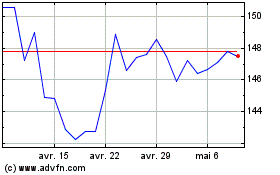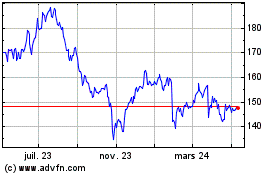Tech Executives Tap Employees for Ideas
20 Août 2019 - 11:51PM
Dow Jones News
By Sara Castellanos
Technology teams at large companies are moving beyond their
traditional role in business support as their bosses encourage them
to use their skills to develop marketable products and
services.
The blurring of lines between IT and business groups reflects
the fact that coding and the ability to analyze data are now
central to product development. Tech teams at large corporations
including credit-card giant Visa Inc. and logistics company United
Parcel Service Inc. have developed new tools for employees and
customers in the past few years.
Employees can get time, and sometimes money, to pursue projects
that executives see as having strong market potential. Accounting
firm Ernst & Young LLP this year gave a team of employees in
Australia $100,000 to build a tool that uses automation to manage
cybersecurity. It is currently being developed for client use.
"It's more important than ever for us to make sure the right
ideas are bubbling up from people on the ground," said Jeff Wong,
global chief innovation officer for Ernst & Young, which brands
itself as EY.
Large organizations need to make an effort to adapt to change
quickly, Mr. Wong said, where in the past, they could afford to
wait to see how change affected the market.
At UPS, the rise of e-commerce and increasing global trade have
spurred "unprecedented demand" for new ideas, said Juan Perez, the
firm's chief information and engineering officer. Because employees
understand customers, their ideas are helping UPS keep pace with
competition and anticipate future needs, he said. "No matter what
level you're in, we all have an obligation to keep thinking of
ideas that make the business better," he added.
Mr. Perez encourages employees to come up with novel ideas and
work with UPS's legal team to patent them. Six employees in Mr.
Perez's IT group came up with a patented idea that was rolled out
in 2017 called Preload Smart Scan.
The system uses Bluetooth-enabled electronic beacons in UPS
delivery vehicles to notify workers if they have placed an item in
the wrong vehicle, a problem that affects delivery timelines. The
beacons send signals to scanners that read package labels, and the
scanner notifies the employee if a package has been misloaded.
A patent developed by a UPS employee is owned by the company;
Mr. Perez came up with 10 patents and has seven pending.
At Visa, all employees are allowed to spend 10% of their time
pursuing new ideas that relate to the company's strategic
objectives.
"Some of the most breakthrough innovations come from the front
lines," said Rajat Taneja, the company's executive vice president
of technology and operations, who helped spearhead the 10% program
five years ago. Fostering a culture that enables significant
innovation has never been more important, he added.
The company prides itself on letting employees test new ideas
without a lot of bureaucracy, through hackathons and internal
forums where employees can get real-time feedback.
Visa's employees have come up with 2,500 ideas to date, some of
which have resulted in new capabilities for artificial
intelligence, security and improving business processes, Mr. Taneja
said.
One such idea resulted in a tool called Visa Transaction
Controls, one of the most frequently used application-programming
interfaces among Visa customers. APIs are pieces of software that
enable apps, platforms and systems to connect with each other and
share data.
The tool was developed by two employees in 2015. Visa customers,
such as banks and small businesses, can integrate the tool into
their apps to let cardholders set spending limits, receive
transaction alerts and temporarily suspend accounts.
Homegrown innovation is particularly important for established
companies, Mr. Taneja said. Being in a dominant position can lead
to complacency. "If you aren't creating and incubating new
ideas...someone else surely is," he said.
Peter Skyttegaard, senior research director at Gartner Inc.,
said innovation has been a popular topic of conversation among
analysts and senior technology leaders in recent months. Older,
more established enterprises are being forced to change more
quickly because of increasing competition, he said: "Part of it is
the fear of being disrupted."
Write to Sara Castellanos at sara.castellanos@wsj.com
(END) Dow Jones Newswires
August 20, 2019 17:36 ET (21:36 GMT)
Copyright (c) 2019 Dow Jones & Company, Inc.
United Parcel Service (NYSE:UPS)
Graphique Historique de l'Action
De Juin 2024 à Juil 2024

United Parcel Service (NYSE:UPS)
Graphique Historique de l'Action
De Juil 2023 à Juil 2024
